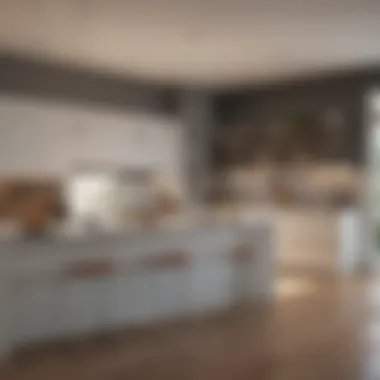Maximizing Home Value: The Power of Staging


Intro
Staging a home is more than merely arranging furniture and adding decor. It is a strategic process aimed at maximizing the appeal of a property to potential buyers. In the competitive real estate market, first impressions matter significantly. A well-staged home translates to heightened buyer interest and can lead to more favorable offers. This article will explore various aspects of home staging, elucidating its importance and providing essential guidance for homeowners.
Design Inspiration
Creating an inviting atmosphere starts with solid design inspiration. Understanding current trends and selecting appropriate color palettes can make a significant difference in staging.
Trending Styles
When staging a home, it is essential to keep abreast of trendy styles. Popular aesthetics include minimalism, which emphasizes simplicity and clean lines, and modern farmhouse, which combines rustic charm with contemporary functionality. Additionally, urban chic has gained traction as well, focusing on industrial elements mixed with modern design.
Staging a home in alignment with these styles can resonate well with a broad audience. It is vital to choose elements that contribute to an overall cohesive look that potential buyers can envision themselves in.
Color Palettes
Color plays a pivotal role in the staging process. Neutral shades like beige, gray, and soft whites create a blank canvas, allowing buyers to imagine their personal touches. Accent colors, such as deep blues or earthy greens, can be incorporated to add interest without overwhelming the space. Each room should reflect a harmonious color flow that guides the viewer seamlessly from one area to another.
"Staging is about creating emotion and connection. The right colors and styles can evoke feelings that foster buyer interest."
Practical Tips
Once the design inspiration is in place, practical tips can ensure a smooth staging process. Proper maintenance and thorough planning will set the stage for success.
Maintenance & Care
Before staging, it is crucial to address any maintenance issues. This includes repairing broken fixtures, freshening paint, and ensuring good lighting. A clean and well-maintained home speaks volumes about care and pride in ownership. Regularly scheduled cleaning sessions can keep the space looking its best.
Budgeting & Planning
Budget considerations are crucial in staging effectively. Allocating funds towards key areas, such as professional photography, can enhance marketing efforts. Planning also involves deciding which elements to purchase or rent, such as furniture and decor.
Creating a detailed staging plan, including timelines and budgets, allows for a structured approach. Consider utilizing resources like professional staging companies, which can provide expertise in maximizing property potential.
By understanding the importance of staging, homeowners can take proactive steps to enhance their chances of selling quickly and at the desired price. Knowledge of design trends and practical care tips form the foundation of effective home staging. Focus on appealing to buyer perception and emotional connection, and you will see significant results in any property sale.
Overview of Home Staging
Staging a home is more than just rearranging furniture or adding new decor. It is a strategic process aimed at enhancing a property’s appeal to potential buyers. Understanding the overview of home staging sets the foundation for grasping its significance in the real estate market today.
Home staging involves preparing a residential property for sale in a way that showcases its strengths while minimizing weaknesses. By presenting the home in its best light, sellers increase the chances of attracting buyers and receiving higher offers. This process often involves decluttering, organizing, and professionally arranging furniture, as well as adjusting color schemes to create a more inviting atmosphere.
The benefits of staging are manifold. A well-staged home encourages prospective buyers to imagine themselves living in the space. It also helps the property stand out in a crowded market, which is crucial given the current competitive nature of real estate. Homes that are staged tend to receive positive attention, leading to quicker sales and potentially higher sales prices.
When considering staging, it's essential to be aware of specific elements that significantly impact the outcome. Factors such as location, current market trends, and buyer demographics play vital roles in determining the effectiveness of staging strategies.
In summary, home staging represents a critical element of selling a property successfully. It is an investment that can yield significant returns, showing not just the potential of a home but also enhancing its marketability.
Definition of Home Staging
Home staging can be defined as the act of preparing a home for sale in the real estate market. This preparation involves not only cleaning and decluttering but also thoughtful arrangement of furniture and decor in a way that highlights the property’s best features. The goal is to make the home appealing to the greatest number of potential buyers. A properly staged home allows potential buyers to envision their lives within that space, increasing the likelihood of making an offer.
History of Home Staging
The concept of home staging is relatively modern, emerging in the 1970s as the real estate market began to evolve. Initially, the idea was introduced by home staging pioneers like Barb Schwartz, who recognized that poorly presented properties often lingered on the market longer than necessary. As a result, she created strategies to help sellers better showcase their homes.
Over the years, home staging has grown in sophistication, integrating various design principles and marketing strategies. With the rise of digital photography and online listings, the visual presentation of homes has become even more critical. Today, home staging is considered a standard practice in many real estate transactions, with professional stagers providing services specifically tailored to boost market appeal.
Impact on Property Value
In today's competitive real estate market, understanding the factors that drive property value is critical. Home staging plays a significant role in this aspect. By effectively arranging furniture, highlighting spaces, and creating an appealing ambiance, a staged home can attract more potential buyers. This increased interest can translate into higher offers. Therefore, it is imperative for homeowners to grasp the impact staging has on their property's market perception and overall worth.
Enhancement of Market Appeal
The first step in recognizing the effect of home staging on property value is appreciating its role in enhancing market appeal. A well-staged home presents itself in the best light, allowing buyers to visualize how they might utilize the space. Staging can draw attention to the unique features of a home that may be overlooked otherwise.
A staged environment often features neutral color palettes, minimal personal items, and a cohesive design style. This strategy can attract a larger audience by creating a sense of warmth and inviting atmosphere. Thus, first impressions are essential; if buyers feel comfortable upon entering, they are more likely to consider making an offer. The perception of a well-maintained, stylish space can lead buyers to believe that the property is worth its asking price or even higher.
Return on Investment
Investing in home staging can yield significant returns when selling a property. Studies show that staged homes can sell up to 73% faster than non-staged ones. This is because potential buyers often find staged homes more visually appealing and easier to envision as their own. Even small changes such as decluttering, rearranging furniture, or adding decorative pieces can result in increased offers.
Homeowners should carefully consider both the costs and benefits of staging. While hiring a professional stager involves an initial investment, the potential returns can outweigh these costs. In some cases, a staged home can see a sale price increase that far surpasses the expense incurred during staging. The goal should be to create an attractive space that people can connect with, as this can lead to not just quick sales but also a broader buyer interest.


"Home staging is not merely a tool; it is a strategic approach that influences buyer decisions and can significantly affect property value."
Ultimately, the synergy between staging and property value is clear. Enhanced market appeal drives interest, and a solid return on investment solidifies the advantages of home staging. For the modern homeowner, these aspects are essential for executing a successful sale.
Psychological Factors in Home Staging
Understanding the psychological factors in home staging is essential for both sellers and real estate professionals. Buyers often make decisions based on emotions, which can greatly influence their perception of a home. By leveraging these psychological elements, sellers can create an inviting atmosphere that resonates with potential buyers, making a strong impression that can encourage quick offers.
Creating Emotional Connections
Emotional connections during a home tour are crucial. When buyers envision themselves living in a space, they are more likely to feel drawn to it. Home staging plays a pivotal role in achieving this emotional connection. It involves personalizing the environment in a way that is appealing but not overwhelming. Neutral decor options often offer a canvas that allows potential buyers to project their own lives onto the space.
Consider the following approaches:
- Incorporate warm colors. Soft tones in common areas can evoke feelings of comfort and welcome.
- Utilize scented elements. Subtle fragrances can make buyers feel more at home, enhancing their overall experience.
- Showcase lifestyle. Use staging techniques that reflect a lifestyle buyers aspire to, like a cozy reading nook or an inviting dining space.
By creating these emotional connections, the likelihood increases that buyers will form a bond with the home, ultimately leading to a successful sale.
Visual Perception and First Impressions
The first impression a home makes is often the most lasting. Visual perception can dictate how potential buyers feel about a property within moments of entering it. Staging helps control and enhance this perception through various techniques.
Address these factors to maximize first impressions:
- Clarity in layout. Homes should be staged to showcase clear pathways and open spaces, allowing easy flow and movement to help buyers visualize themselves navigating the area.
- Highlight natural light. Bright, well-lit spaces tend to appeal more than dark, confined areas. Consider sheer curtains that let in light without sacrificing privacy.
- Balance of decor. Properly positioned furniture can create visual harmony, assisting buyers in feeling the space's full potential without clutter or distractions.
Overall, the psychological aspects of home staging not only influence buyer preferences but also play a significant role in the final sale. By addressing emotional connections and visual perceptions effectively, sellers can enhance their home's marketability.
Elements of Effective Home Staging
Effective home staging is crucial in creating an inviting atmosphere that resonates with potential buyers. This section analyzes key components that contribute to successful home staging. Each element has its specific benefits and considerations, which can help in enhancing the home’s appeal in the competitive real estate market.
Decluttering and Organizing
Decluttering and organizing is one of the most powerful steps in home staging. When a space is cluttered with personal belongings, it becomes difficult for buyers to envision themselves living there. An organized environment helps emphasize the space’s potential. In this context, it is vital to remove excess items, personal photographs, and any furnishings that might distract the viewer.
A well-organized home allows buyers to focus on the architecture, layout, and function of each room rather than being overwhelmed by clutter. Potential buyers tend to view homes with minimalistic design as more spacious. One great practice includes sorting out belongings into categories: keep, donate, and discard. This systematic approach reduces excess and fills the home with a clean, open atmosphere, which is inviting.
Furniture Arrangement Techniques
The arrangement of furniture plays a significant role in staging a home effectively. Proper furniture layout can enhance the flow of a room while also highlighting its features. Buyers appreciate a well-furnished space that maximizes utility and comfort.
It is important to anchor furniture to create conversational areas, especially in living rooms. Placing sofas and chairs in a semicircle encourages interaction and makes the space feel inviting. Additionally, leaving pathways clear between pieces ensures easy mobility throughout the area.
Key points to consider in furniture arrangement:
- Scale and proportion: Use appropriately sized furniture for each room.
- Functionality: Ensure each area is practical and serves a purpose.
- Focal points: Highlight key features such as fireplaces or windows to draw attention.
By considering these techniques, the property can be showcased in a way that appeals to a wide range of buyers.
Color Schemes and Lighting
Colors and lighting are fundamental in creating mood and ambiance. A thoughtful color scheme can evoke emotions and set the tone for each room. Neutral colors usually dominate successful staging because they provide a blank canvas, allowing buyers to imagine their personal touches.
Additionally, lighting significantly enhances the home’s allure. Natural light is preferred; it brightens spaces and makes them appear larger. To maximize light, open drapes and use mirrors strategically to reflect brightness.
Considerations for color schemes and lighting include:
- Balance: Use a mix of warm and cool tones to create a harmonious environment.
- Accent colors: Introduce subtle pops of color through accessories to make spaces vibrant.
- Layered lighting: Combine ambient, task, and accent lighting to create warmth and comfort.
Utilizing these elements will greatly enhance a home’s staging to resonate well with potential buyers.
Staging Specific Areas of the Home
Staging specific areas of the home is essential in creating a cohesive and appealing atmosphere that prospective buyers find attractive. Each space within a house serves its unique purpose and functions, thus requiring a tailored approach for staging. The goal is to highlight features that resonate with the buyer’s emotions and vision for their potential new home. When effectively staged, specific areas can showcase their best qualities, making it easier for buyers to imagine themselves living in the space. This strategic presentation can lead to quicker sales and potentially higher offers.
Living Room Staging
The living room often serves as the heart of the home. Its staging focuses on creating a warm and inviting environment. This area should feel spacious yet comfortable, encouraging visitors to linger. By arranging furniture in a way that promotes conversation, a well-staged living room can foster a sense of community and connection. A neutral color palette can enhance the room’s appeal, while strategically placed accessories can add personal touches without overwhelming the space.
Key considerations for living room staging include:
- Decluttering: Remove non-essential items to create an open feel.
- Furniture Arrangement: Use furniture that fosters engagement and movement.
- Lighting: Employ soft, warm lighting to create a welcoming ambiance.


Kitchen Staging
The kitchen is not only a functional space but often the hub for family gatherings. Staging this area involves highlighting cleanliness, functionality, and style. Potential buyers should be able to envision cooking and socializing here. Simple updates, like adding fresh flowers, can make a significant impact. Open shelving can showcase attractive dishware, while counter space should be free of clutter to exhibit usability.
Important tactics for staging the kitchen:
- Cleanliness: Ensure countertops and appliances are spotless.
- Declutter: Store away items that are not frequently used.
- Visual Interest: Use decorative bowls or well-placed cookbooks for a lived-in feel.
Bedroom Staging
Bedrooms should exude tranquility and comfort, promoting relaxation. When staging bedrooms, it is vital to create a serene environment. Neutral colors serve to enhance relaxation, while carefully chosen bedding can make the space inviting. Effective use of space is also crucial; showcasing closet space can appeal to buyers who value storage.
Considerations for staged bedrooms:
- Minimalism: Keep decor simple to allow buyers to envision their own taste.
- Bedding: Use high-quality linens that create a cozy atmosphere.
- Lighting: Incorporate dimmable lights for mood options.
Outdoor Space Staging
Outdoor areas, including patios, gardens, and backyards, are increasingly important to buyers. Staging these spaces can elevate a home’s appeal, especially in regions where outdoor living is favored. Ensuring that gardens are well-maintained and outdoor furniture is arranged for comfort and conversation can significantly enhance a property's allure.
Key points for staging outdoor spaces:
- Cleanliness: Rake leaves, mow lawns, and remove debris to present a cared-for space.
- Furniture Arrangement: Set up seating to encourage outdoor entertaining.
- Landscape Touches: Add potted plants to introduce color and life.
"A well-staged home creates an emotional connection with buyers, making it feel more inviting and desirable."
Focusing on specific areas of the home is critical for maximizing the impact of staging. When each room is carefully considered and presented, the overall effect can lead to a stronger market presence and higher sale prices. By applying these principles, homeowners can significantly enhance the buyer experience.
Common Mistakes in Home Staging
Identifying common mistakes in home staging is essential for any homeowner looking to attract potential buyers. The success of staging hinges not just on strategic decor but on understanding what can deter buyers as well. When staging a home, avoiding pitfalls can greatly enhance its appeal, lead to faster sales, and ultimately raise property values. In this section, we will explore two prevalent mistakes: over-personalization and neglecting repairs.
Over-Personalization
Over-personalization is a significant mistake that many homeowners encounter during the staging process. It occurs when a homeowner decorates their space in a way that reflects their personal taste too strongly. While it may be comfortable for the current owners, personal items can make it challenging for potential buyers to envision themselves living in the space.
To prevent this, homeowners should aim for a neutral and inviting atmosphere. This can be achieved by removing family photos, unique artwork, or any decor that speaks to personal experiences. Instead, opting for neutral colors and simple decor can be more effective.
Here are some key considerations:
- Neutral Colors: Walls painted in neutral tones create a blank canvas for buyers.
- Generic Artwork: Choose art that is not specific to your personal taste but still conveys a sense of style.
- Minimal Personal Items: Remove personal effects that may not appeal to a broad audience.
Neglecting Repairs
Neglecting repairs is another costly mistake in home staging. Buyers often look closely at a property's condition, and any signs of neglect can create doubts about the home’s overall upkeep. Small repairs, such as fixing leaky faucets, patching holes in walls, or replacing broken tiles, can greatly improve the first impression of a home.
Addressing these issues before staging is important. Here are the main reasons why this should not be overlooked:
- First Impressions Matter: A well-maintained property signals to buyers that they can move in without immediate concerns.
- Investing Time: Taking time to conduct repairs can yield a higher return on investment.
- Showcasing Potential: A home that appears well-kept encourages buyers to see its full potential.
"A well-staged home is not just about aesthetics—it's also about ensuring the foundation is solid for potential buyers to build their future."
To summarize, avoiding over-personalization and neglecting repairs can make a significant difference in staging outcomes. By removing personal items and addressing repairs, homeowners can create a space that invites buyers to imagine their lives within the home.
Professional vs. DIY Staging
Staging a home can be approached in two primary ways: hiring a professional or embarking on a do-it-yourself journey. Both paths come with distinct advantages and considerations, and understanding these can significantly impact the effectiveness of the staging process. A well-staged home can captivate potential buyers, so making an informed choice on how to stage your home is crucial.
When to Hire a Professional Stager
Opting for a professional stager typically makes sense in specific situations. First, if the property is high-end or luxury, professional stagers can curate a sophisticated atmosphere that resonates with affluent buyers. Luxury markets expect a certain standard, which a professional can deliver through expertise in current trends and buyer preferences.
Another scenario where hiring a professional is advantageous involves homes that are vacant or have unusual layouts. A professional has the resources and experience to make the most out of spaces that may feel empty or awkwardly configured. They understand how to use furniture and decor to define each area of a room without overwhelming it.
Situations such as tight timelines can also necessitate professional help. If a homeowner needs to sell quickly, a stager can efficiently arrange the space to make it market-ready without compromising quality.
"A professional stager's insight can turn an ordinary space into a welcoming home, often leading to quicker and more lucrative sales."
Benefits of DIY Staging
Choosing the DIY route offers its own set of merits worth considering. Primarily, one of the most appealing aspects is cost savings. DIY staging requires no professional fees, allowing homeowners to allocate funds elsewhere, possibly towards necessary repairs or upgrades.
Additionally, DIY staging permits a personal touch. Homeowners have the opportunity to showcase their unique style and the property’s character, fostering a connection with potential buyers. It is also a chance to declutter and reorganize spaces, providing additional functional benefits while preparing for viewings.


Many online resources and tutorials can guide homeowners through effective staging techniques. Embracing DIY staging can enhance creativity and offer a sense of pride in the property. Here are several practical benefits of choosing DIY staging:
- Cost Efficiency: Save on professional fees.
- Personal Touch: Infuse your individual style into the home.
- Flexibility: Stage at your own pace.
- Skill Development: Enhance your home design skills for future projects.
Careful planning is essential for both methods. Assess your home’s condition, consider your timeframe, and weigh your budget. Ultimately, the choice between professional and DIY staging should align with your particular needs and circumstances.
The Role of Virtual Staging
Virtual staging has become increasingly significant in the real estate market. It uses digital technology to create realistic images of staged homes. Home sellers can showcase their properties without needing to physically furnish or style them. As a result, virtual staging can save time and resources.
Another advantage is the ability to appeal to broader audiences. Different buyers have diverse tastes. Virtual staging enables sellers to highlight various styles, whether modern, traditional, or eclectic. This customization can help buyers envision what the space could look like.
However, it’s important to ensure that virtual staging matches the home’s actual layout and features. Misrepresentation can lead to disappointments during property viewings and may even harm the seller’s reputation. Transparency about the use of virtual staging is vital.
Technology in Home Staging
The advent of technology has transformed home staging practices. Digital tools allow stagers to create attractive spaces quickly. Software now provides high-quality virtual renderings, enabling potential buyers to visualize their future homes.
Some popular tools in this field includes 3D visualization software like SketchUp and RoomScan Pro. These applications facilitate virtual tours and detailed floor plans. It makes the home appear more appealing when presented online. Pictures and videos are crucial in online listings; therefore, technology enhances the presentation substantially.
Moreover, virtual reality options are also emerging. Buyers can immerse themselves in a home without being physically present. This feature can be especially beneficial for out-of-town buyers or those under time constraints.
Key Benefits of Technology in Home Staging
- Cost-Effective: Virtual staging is typically less expensive than physical staging.
- Flexibility: Stagers can easily change designs or furniture styles for different marketing strategies.
- Wider Reach: Online platforms enable the staging images to reach a larger audience.
Limitations of Virtual Staging
Despite the advantages, virtual staging has limitations. One key concern is the authenticity of the images. Buyers may become skeptical if they believe the portrayal does not match reality. Additionally, overly glamorized images can lead to disappointment when viewing the actual space.
Furthermore, not all homes can benefit equally from virtual staging. Older properties or homes with unique layouts may require more detailed physical staging to convey their true potential. In those cases, relying solely on virtual options might not be effective.
"Virtual staging can bring life to empty rooms, but it should never replace the real experience of a home."
Emphasizing realism and transparency in staging is essential for keeping buyer trust intact.
Staging for Specific Markets
Staging a home is not a one-size-fits-all approach. Different markets demand unique strategies to captivate potential buyers. Tailoring staging efforts can greatly enhance a property's appeal, helping it stand out in the competitive landscape. It is essential to understand the specific audience you are targeting, whether it be luxury buyers or first-time home purchasers. This understanding can influence decisions on design, decor, and even the overall vibe of the home.
Home staging for specific markets highlights key considerations:
- Target Audience: Knowing the preferences and expectations of your audience can guide staging choices.
- Market Trends: Staying up to date with current trends ensures that the staging feels modern and desirable.
- Investment Priority: Different markets might require varying levels of investment in staging. Understanding this can lead to a more effective allocation of resources.
Luxury Home Staging
Staging luxury homes requires a sophisticated approach. Wealthy buyers often have refined tastes and expect high-end details. Here, the goal is to create a lifestyle that feels exclusive yet inviting. This involves an emphasis on quality over quantity.
A few important elements of staging luxury homes include:
- High-Quality Furnishings: Select upscale furniture pieces that resonate with luxury, using names like Restoration Hardware or Ethan Allen can create the desired ambiance.
- Minimalist Design: Avoid cluttered spaces. Clean lines and spacious layouts appeal to luxury buyers.
- Personal Touches: Adding unique art or bespoke decor can create an emotional connection, making the space feel special.
Effective luxury staging can yield significant dividends. Properties that are well-staged in this market generally see expedited sales and higher offers.
Staging for First-Time Buyers
In contrast, first-time buyers often look for practicality and affordability. This demographic tends to focus on function, potential, and cost, rather than an opulent lifestyle. Therefore, the staging should highlight how the home can meet their needs.
Key strategies for staging aimed at first-time buyers include:
- Highlighting Space Utilization: Show how rooms can be used in different ways. This could involve setting up a home office in the guest bedroom or creating a cozy reading nook in the living area.
- Budget-Friendly Decor: Using decor that feels stylish yet affordable can resonate well. Resources like IKEA or HomeGoods offer various options that can make a space look inviting without breaking the bank.
- Emphasizing Community: Often, first-time buyers are drawn to community features. This can be promoted by staging a welcoming outdoor space or emphasizing nearby parks and schools.
The End
In this section, we emphasize the significance of home staging in the real estate landscape. Staging is not merely about decorating; it involves a strategic approach that enhances the property's appeal to potential buyers. It encompasses various elements, such as layout optimization, aesthetic uniformity, and the creation of an inviting atmosphere. Understanding these aspects can lead to significant advantages in the selling process.
Summary of Key Points
Home staging plays a pivotal role in the sale of a property. Here are the key points that capture its essence:
- Enhanced Market Value: Staging improves the overall perception of a home, often resulting in higher offers and quicker sales.
- Psychological Impact: Staging allows buyers to imagine themselves in the space, fostering emotional connections that can drive their purchase decisions.
- Strategic Space Management: Effective staging employs thoughtful arrangement of furniture and decor, which maximizes the use of space.
- Highlighting Unique Features: Staging can accentuate the strengths of a home, whether it is a large kitchen or a cozy living room.
By grasping these points, homeowners can appreciate why staging is an essential component of the selling process. It is not only about creating visual appeal but also about making a strategic investment in their property's future.
Final Thoughts on Home Staging
Staging is both an art and a science. It requires attention to detail, an understanding of market desires, and knowledge of design principles. As the real estate market continues to evolve, one thing remains constant: homes that are thoughtfully staged stand out in the competitive landscape.
"A well-staged home speaks to the buyers’ imaginations, helping them envisage their lives in that space."
Ultimately, staging is about creating an environment where people see their future, and that can make all the difference.















